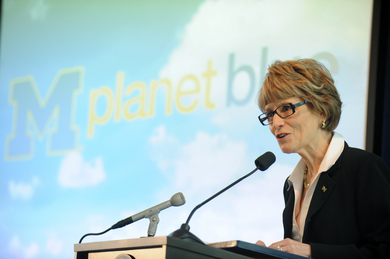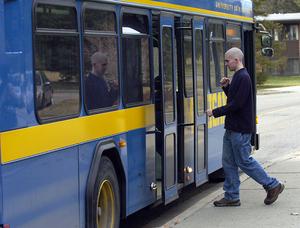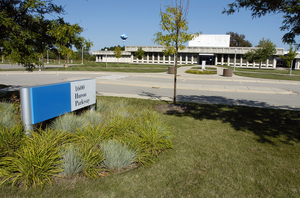By the numbers: University of Michigan tries to balance sustainability with growing campus
The University of Michigan is working to balance an increasing focus on sustainable practices with a growing facility and student body size, a balance that, according to data from a recent university-generated report, is not always easy to strike.

University of Michigan President Mary Sue Coleman announces new sustainability goals for the campus during a September gathering.
Angela Cesere | AnnArbor.com
University of Michigan President Mary Sue Coleman in September pledged to greatly reduce the amount of waste, emissions, toxic run-off and energy consumed by the university, saying that sustainability "will begin to infuse everything" at the Ann Arbor campus.
Upholding the pledge, however, is no easy feat, according to the 2011 U-M Sustainability Report.
During the course of seven years, the university's student body has increased 8 percent since 2004, growing from 39,533 to 42,716. Simultaneously, the school's square footage has increased tremendously with the construction of North Quad, South and Weill halls and the acquisition of the former Pfizer buildings, among several other projects.
New data shows that the university still has many changes to implement if it's going to succeed in reducing its waste and meeting its ambitious sustainability goals.
AnnArbor.com picked some numbers that reflect the university's progress in waste reduction, as well as areas it still needs to work on to reach those goals.
2: The number of consecutive years U-M's greenhouse gas emissions have increased.
According to the recently released report, greenhouse gas emissions increased 7.5 percent this year, marking the second-straight year of increase and bringing the school's total emissions increase since 2004 to 28 percent.
However the school's emissions, when normalized for growth, showed a 5.8 percent decrease since 2004 and a 4.9 percent increase from fiscal 2010 to fiscal 2011.
The report says the university's acquisition of the Pfizer building, renamed the North Campus Research Complex, is the primary reason behind the 2011 emissions increase.
7: The number of hybrid buses the school plans to roll out this year.

A rider prepares to board a University of Michigan bus
AnnArbor.com file photo
University figures show bus ridership on campus rose from 6.5 million rides in fiscal 2010 to 6.9 million rides in fiscal 2011. Although the number of riders has increased, the school has been able to curb the amount of energy and fuel used per rider, the report asserts.
The school owns more than 1,050 vehicles, including 96 biodiesel buses and trucks, 55 hybrid sedans and 15 electric vehicles. U-M will be adding seven hybrid buses to its fleet this year as a part of its sustainability initiative.
18: The percentage decrease in energy consumption at Angell Hall, one of U-M's largest classroom and faculty office buildings, during fiscal 2011.

The former Pfizer site now owned by the University of Michigan. The school is reportedly planning to install solar panels on site.
AnnArbor.com files
Energy consumption of 387 surveyed buildings increased 8.2 percent from 2004 to 2011, according to the report. From 2010 to 2011, the increase in energy usage at those buildings was 3.8 percent.
The university has concentrated its energy-reduction efforts on 71 existing buildings since 2004. The result is an 8 percent decrease of energy consumption in those buildings, the report states. Angell Hall, one of those buildings, saw an 18 percent energy consumption decrease; the Alumni Center saw a 16 percent decrease, and the Crisler Center saw a 30 percent reduction.
U-M plans to install a field of solar panels on North Campus in the coming year. The panels will create enough energy to power about 50 households, Coleman said in September.
430: How many pounds of waste the university generated per person in fiscal 2011.
The university decreased its waste 2.7 percent from 2010, to 17,000 tons in fiscal 2011. That number, however, is a 19 percent increase from 2004. In 2011, the university produced 1.2 pounds per student, staff and faculty per day, or 430 pounds per person during the year.
According to the report, the school has a 30 percent recycling rate. In September, the university reinstalled recycling bins on the Diag. The bins had previously been removed because they were often used for waste. After Ann Arbor moved to single-stream recycling, the university reinstalled the bins, optimistic they'd be used for mostly recyclable waste.
The school also composts most of its pre-consumption food waste and uses recycled napkins in dining halls.
1.3 billion: The number of gallons of water used at the university in fiscal 2011
Water use at the university increased by 6.2 percent from fiscal 2010, rising to 1.3 billion gallons in 2011, or about 16,000 gallons per person. However, when normalized for population growth, the number actually marks a 7.1 percent reduction in usage from 2004, the report asserts.
U-M's sprinkler systems are computer monitored to reflect recent rainfall. The university says that saves about 22 million gallons of water per year.
Officials from U-M's Office of Campus Sustainability could not be reached for comment on the report today.
Kellie Woodhouse covers higher education for AnnArbor.com. Reach her at kelliewoodhouse@annarbor.com or 734-623-4602 and follow her on twitter.


Comments
Rita Mitchell
Tue, Jan 17, 2012 : 9:25 p.m.
UM's own study of parking indicates that additional parking in the center of the campus and the center of Ann Arbor is not sustainable. A proposed parking structure in Fuller Park will encourage continued use of automobiles in the center of Ann Arbor, and in the Huron River Valley. The cars will contribute to additional air pollution and traffic in an area already considered below optimal for traffic. The University should work with the AATA to support alternate transportation within the city, to reduce the ride and park problems experienced by those who have to travel to meetings from their offices. Now is the time to take a big step in the sustainability movement. Building a parking structure in a park, near the river is antithetical to the sustainability process.
BobbyJohn
Tue, Jan 17, 2012 : 4:46 p.m.
If one walks around campus for just 15 minutes, he/she will see that there are hundreds of outside lights on during daylight hours. Some of them have been continuously for decades! I have given up reporting them to the U because the reports are ignored. Then, look at the # of windows that are open on campus during heating season. Let's attack the low lying fruit first, before doing things that have paybacks of over 25 years, such as photovoltaic solar and wind energy. Since UM doesn't pay taxes, they cannot take advantage of huge federal and state tax credits and subsidies available to taxpayers that makes these options more affordable. Conservation costs almost nothing and has the greatest potential to reduce energy costs. Stop the waste.
Kai Petainen
Tue, Jan 17, 2012 : 4:06 a.m.
"pledged to greatly reduce the amount of waste, emissions, toxic run-off " i'm happy to hear that folks are working on this -- fantastic stuff.
Dcam
Tue, Jan 17, 2012 : 4:15 p.m.
Bromides always get high praise.
Ron Granger
Mon, Jan 16, 2012 : 10:20 p.m.
Coleman and the regents have demonstrated time and again that they have absolutely no regard for the city of Ann Arbor and the residents who actually live here.
Dcam
Tue, Jan 17, 2012 : 4:19 p.m.
Sparty, every UM job is a job that is not in the private sector and is an additional burden on taxpayers to fund. And every UM owned business is a business that competes unfairly with the private sector and disincentifies real entrepreneurs - who actually create sustainable business because they invest themselves and their own money into it.
Dcam
Tue, Jan 17, 2012 : 4:11 p.m.
Lolly, I suspplied some facts, but AA.com deleted them as abusing its head-in-the-sand guidelines. And those facts were the actual dates (the late 1800s) with legal references giving UM regents dominion over the city of Ann Arbor - effectively declaring UM to be a sovereign principality answerable only to itself, with right of eminent domain. The final statement was that UM shall not be constrained by surrounding property owner-citizens.
Lolly
Tue, Jan 17, 2012 : 12:35 p.m.
Ron: If you have a fact or two to share, please do so. Your remark has no validity without something specific you can name.
Sparty
Tue, Jan 17, 2012 : 3:48 a.m.
How's that? By employing more than the next 24 largest employers in the county? Where is that money spent and by whom? By bringing in 40,000+ students who pay to live, eat, and entertain themselves while here? By bringing in 110,000 sporting fans regularly to eat, park, and enjoy the city whilseen town to see the event? Maybe I'm just confused?
Thaddeus
Mon, Jan 16, 2012 : 8:27 p.m.
Maybe I overlooked something, but I see nothing about the sustainability of paying top wage earners ever-BIGGER salaries when most of UofM's staff is very low-paid, hard-working, under-appreciated/ exploited, often working in very trying conditions, and being ever further squeezed.... Particularly as the UofM is a tax-exempt (if you believe the delusion) institution of "higher education" so such wage descrepencies need to be addressed.... I am a strong supporter of and liver of green practices, but the human eliment needs to be included....
jcj
Mon, Jan 16, 2012 : 8:23 p.m.
$760,196 Total annual compensation for Mary Sue!
blahblahblah
Mon, Jan 16, 2012 : 7:59 p.m.
1000: The number of new parking spaces in the proposed Fuller Station parking structure. 0: Number of votes Ann Arbor taxpayers will be allowed to cast in decision to giveaway city parkland for this parking structure.
AnnArBo
Mon, Jan 16, 2012 : 7:44 p.m.
Wonderful.............too bad they are not as concerned about the ridiculous cost of tuition that keeps rising faster than just about every other other cost in our lives.